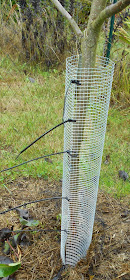 |
| El Dorado Peach Tree, Uprooted. 10.29.14 |
I love peaches but it's been quite difficult growing them here. The main problem is devastating peach lead curl disease.
This El Dorado Genetic Dwarf Peach tree is really too big to dig up. It a robust, 6 foot tall tree, well branched. I started digging yesterday, and finished today. I dug a trench in a wide circle around the tree, then tried to slice under the tree with a shovel. I was surprised there was a large thick tap-root. I had to cut through it to release the tree. I pruned to even up the somewhat rough cut, trying to minimize removal of any more feeder roots.
Most of the other roots look ok. Even though the root pruning was drastic, I've seen worse and the tree survived. It does look very drastic to me. Being fall, there is a chance the tree will re-root itself with feeder roots despite removal of the anchor root.
Reasons it might not live -
*Too drastic removal of roots.
*Residual leaf curl disease on the stems.
*Root mass may freeze. I plan to keep the tree outside because it needs chill time in order to bloom.
If the tree survives, it will make a nice ornamental. Genetic dwarf peaches bloom beautifully.
Based on the tree planting info from Linda Chalker-Scott debunking horticultural myths, I did not top the tree or prune top to compensate for loss of root mass. I did remove dead twigs. There were a lot of those.
For this winter, I intend to keep the tree under house overhang, on the North side of the house. That location may also keep it cooler, and delay bloom, which would be good. But it it does bloom, and frost threatens, I can move it inside on chilly nights. Next Spring and Summer I can keep it on the deck, for TLC.
 |
| El Dorado Peach Tree, Potted. 10.29.14 |
There are also the peach seedlings at battleground. They survived potting up and look nice and healthy.
I want at least 2 cherry seedlings in order to create Japanese cherry trees. I think sweet cherry seedlings should be very robust and make a nice tree. This was a volunteer sweet cherry from the yard. At Battleground I also have a few sweet cherry seedlings. By growing them in containers for a season, I can protect them and give TLC, as I do with figs, for maximal growth. It would be nice to be able to bud graft at least one, next year.
While I was at it, I also potted up the volunteer fig tree from the front of the house. It had nice roots. Based on inspection, it was a stem or cutting, I just don't know from which variety or why it was there.
 |
| El Dorado Peach before moving. 10.28.14 |
 |
| Volunteer Fig Bare Root. 10.29.14 |
 |
| Sweet Cherry Seedling. 10.29.14 |
 |
| "Volunteer" Fig and Cherry Seedlings, Potted. 10.29.14 |



















































